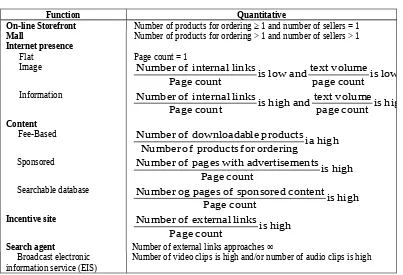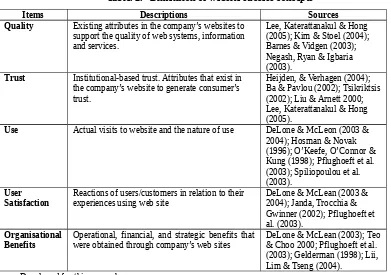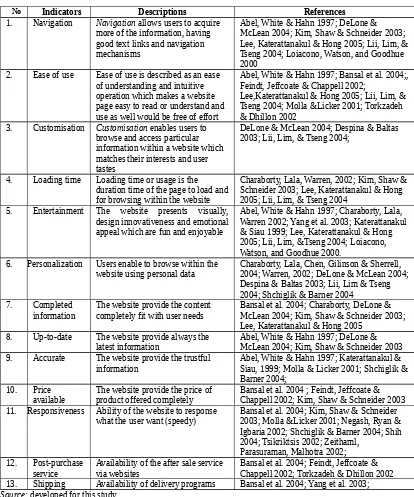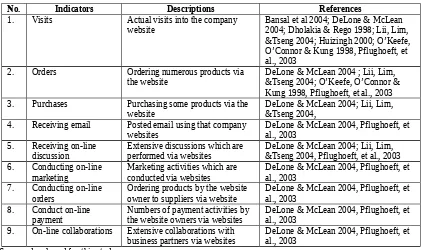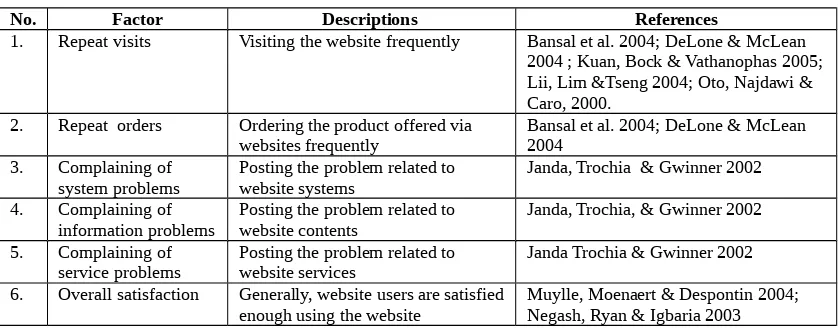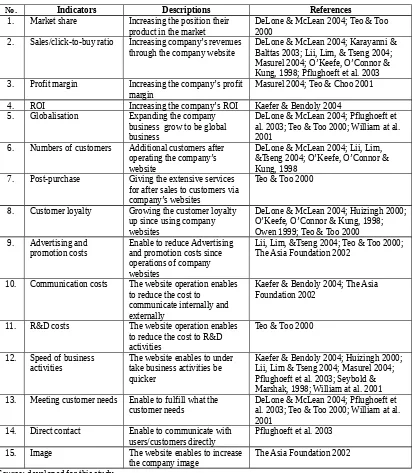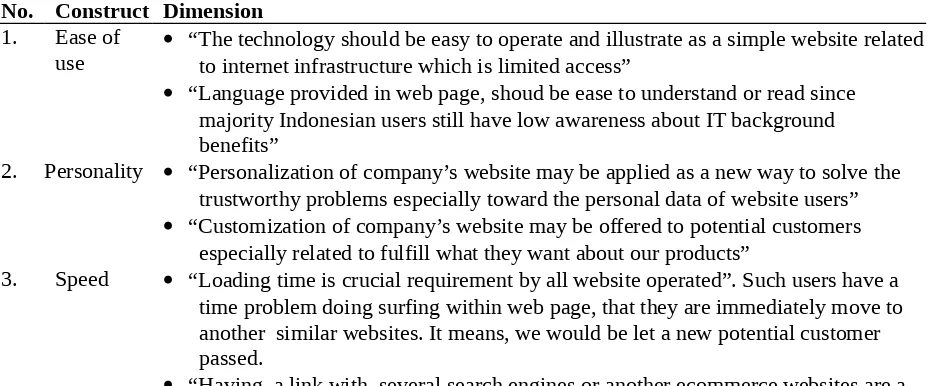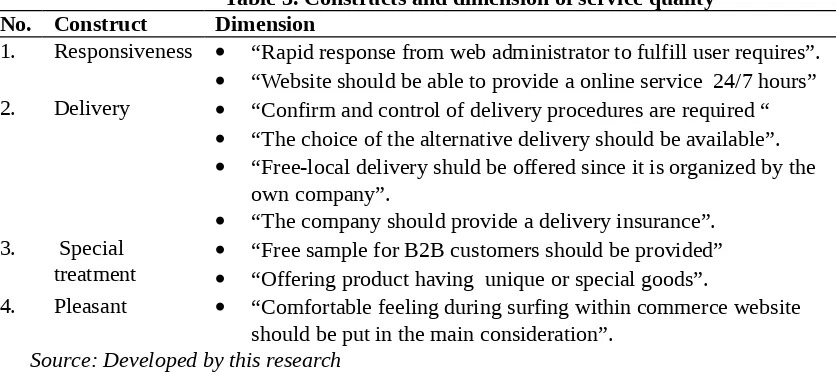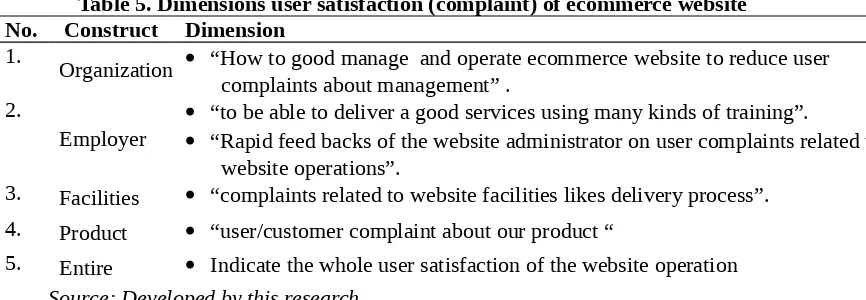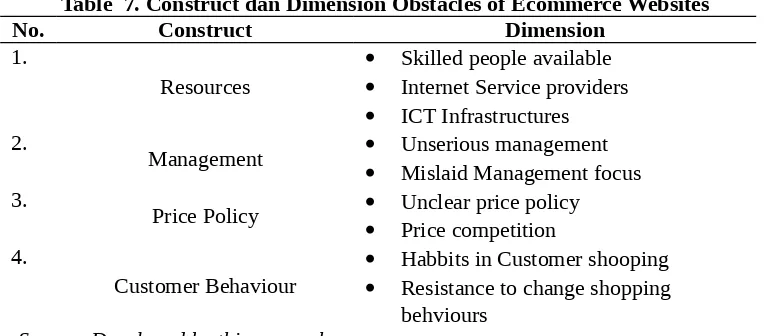LAPORAN EKSEKUTIF
PENELITIAN HIBAH BERSAING
Model Penggunaan
Website
E-Commerce
di Indonesia:
Analisa Kualitatif dan Kuantitatif
Oleh:
Dr. VERA PUJANI, SE, MM
ERIBESRA, SE, MM
Surat Perjanjian Pelaksanaan Hibah Penelitian Tahun Anggaran 2008,
Nomor: 126.a/H.16/PL/HB-PHB/IV/2009
LEMBAGA PENELITIAN UNIVERSITAS ANDALAS PADANG
Gedung Rektoral Lantai II Kampus Universitas Andalas Limau Manih, Padang-25163Telp/Fax. (0751) 72645 E-mail: lpua@padang.wasantara.net.id
November 2009
Model Penggunaan
Website
E-Commerce
di Indonesia :
Analisa Kualitatif dan Kuantitatif
1)Oleh
Vera Pujani dan Eribesra
2)1. PERMASALAH DAN TUJUAN PENELITIAN
Dengan menggacu kepada penelitian sebelumnya yang kebanyakan dilakukan di negara
maju dan negara Barat, penelitian ini akan mengidentifikasi tentang “bagaimanakah
faktor kualitas dan fitur mempengaruhi penggunaan dan kepuasan pengguna (users)
website ecommerce di Indonesia?”.
Kegiatan penelitian ini adalah untuk membangun suatu model penggunaan situs
perusahaan e-commerce
yang efektif melalui pendekatan kuantitatif. Oleh karena itu,
penelitian ini bertujuan untuk:
1. mengetahui faktor-faktor kualitas dan fitur yang mempengaruhi penggunaan
website/situs e-commerce di Indonesia.
2. mengetahui faktor-faktor kualitas dan fitur yang mempengaruhi kepuasan pengguna
website e-commerce di Indonesia.
2. INOVASI IPTEKS
Perkembangan teknologi internet di Indonesia sudah semakin maju, ini terbukti
deningkatnya jumlah pengguna internet mencapai 20 juta orang
(
Internet World Stats,
2007) dan jumlah domain meningkat dari 1,479 pada tahun 1998 menjadi 21,762 tahun
2004 (APJII 2005). Oleh karena itu, penggunaan internet untuk dunia usaha sudah semesti
dipertimbangkan oleh para pengusaha Indonesia untuk dapat unggul dalam persaingan.
a. Kontribusi terhadap pembaharuan dan pengembangan ipteks
Hasil penelitian ini mampu memberikan kontribusi sebagai suatu acuan dan petunjuk
bagi para pengusaha yang akan menggunakan situs perusahaan ataupun bagi
perusahaan yang sudah memilikinya. Kajian ini akan mempunyai dampak semakin
banyaknya pengusaha Indonesia menggunakan website perusahaan secara intensif dan
berdampak terhadap industri IT di Indonesia.
b. Perluasan cakupan penelitian
Hasil penelitian ini tidak hanya berkaitan dengan perusahaan dan teknologi informasi,
akan tetapi juga berhubungan dengan aspek pemahaman tentang ilmu teknologi
informasi oleh
users,
prilaku konsumen, perkembangan kemajuan teknologi, sistem
legalisasi dan sistem perekonomian negara yang akan mempengaruhi keberhasilan
suatu situs perusahaan. Oleh karena itu, hasil penelitian dapat ditinjau lebih dalam dari
aspek-aspek tersebut di atas.
3. KONTRIBUSI TERHADAP PEMBANGUNAN
Hasil penelitian ini akan memberikan kontribusi terhadap pembangunan antara lain:
a.
Dalam mengatasi masalah pembangunan
Indonesia yang terdiri ribuan pulau menimbulkan masalah penting bagi dunia usaha
terutama dari aspek pemasaran, distribusi dan transportasi. Penggunaan internet bagi
dunia usaha adalah solusi penting dari masalah geografi tersebut. Sehingga akan
mendorongnya perkembangan ekonomi dan pembagunan di Indonesia.
b.
Penerapan teknologi ke arah komersial
Penerapan teknologi internet dikalangan pengusaha Indonesia akan muncul melalui
penerapan hasil kajian ini. Sehingga teknologi internet dapat membantu perusahaan
untuk memenangi persaingan dalam dunia usaha.
c.
Alih teknologi
Hasil penelitian ini memberikan sebuah model yang efektif dalam menggunakan situs
perusahaan, sehingga akan membantu para pengusaha untuk melakukan alih teknologi
dari yang tradisional menjadi komputerisasi atau dari penggunaan komputer statis
menjadi dinamis (internet).
d.
Kelayakan memperoleh hak paten/cipta
Disain situs perusahaan yang efektif dari hasil penelitian ini, layak untuk dipatenkan
setelah diuji coba terhadap beberapa situs perusahaan di Indonesia.
4. MANFAAT BAGI INSTITUSI
a.
Keterlibatan unit-unit di perguruan tinggi dalam pelasanaan penelitian
Penelitian ini melibatkan dua universitas lainnya disamping Unversitas Andalas yaitu
Universitas Mataram dan Mercu Buana untuk melakukan survei kepada pengguna
internet dan
website
di lokasi masing-masing
.
b.
Keterlibatan mahasiswa S1 dalam penulisan tugas akhir
.
4. PUBLIKASI ILMIAH
a. Sejumlah publikasi dari tim peneliti ditampilkan pada halaman Lampiran 1.
b. Contoh publikasi disertakan di Lampiran 2.
LAMPIRAN 1. PUBLIKASI ILMIAH
1. Pujani, V. 2007, Dimension of E-Commerce Website Success; A Literatur Survey,
Jurnal Bisnis & Manajemen;
FE-UA, Vol.3(2), hal. 63-76.
2. Meutia, dan Pujani, V. 2007, Adopsi
Automated Teller Machine
(ATM) dengan
Pendekatan
Technology Acceptance Model
(TAM); Studi pada Nasabah Perbankan
Kota Padang,
Jurnal Bisnis & Manajemen;
FE-UA, Vol.3(2), , hal. 102-110.
3. Pujani, V. 2007, The use of the E-commerce Websites among Indonesian SMEs: A
Response Analysis,
Journal Bisnis & Manajemen; FE-UNAND
, Vol.3 (1), hal. 12-29.
4. Pujani, V., dan Xu, J, 2007, Testing a model of website success: A study of Indonesian
SMEs, 2006,
Proceeding of 7
thInternational We-B (Working for E-Business)
Conference,
29
th, 30
thNovember and 1
stDecember, Australia, pp. 167-175.
5. Pujani, V. 2006, Development of Website Success Model for E-commerce in Indonesia
SMEs,
Proceeding of International Conference Environment Challenges of Services
Industry in Asia Pacific
, 2-5 August, Bukitinggi, pp.1-11.
6. Pujani, V., Xu, J., 2005, E-commerce in Indonesia SMEs: Towards a Research Model
of Website Success, 2005,
Proceeding of International Conference Service Systems and
Services Management (ICSSSM),
June 13-15, China, pp.762-767.
7. Pujani, V. 2005, The effective website for e-commerce activities in SME environment,
LAMPIRAN 2. CONTOH
PUBLIKASI PENELITI
DIMENSION OF E-COMMERCE WEBSITES SUCCESS; A LITERATURE SURVEY
Vera Pujani
Abstract
The purpose of this paper is to present the literature survey of numerous journals related to the dimension of the website success. The success dimension is developed based on the DeLone and McLean’s information system success model. The success of the web sites is identified as the website quality, trust, use, user satisfaction and benefits. These concepts are important factors on the website usage. The initial study and research model to build the empirical study of the website success model is provided.
Keywords
E-Commerce, Website, Conceptual Success
1. INTRODUCTION
Electronic commerce has grown rapidly around the world since its first use in 1965, when consumers were first able to withdraw money from Automatic Teller Machines (ATMs), followed by the emergence of internet-based technologies in the early 1990s (Molla & Licker 2001). Today, e-commerce is illustrated as internetworked e-business and e-commerce systems (O’Brien 2002; Protogeros 2001; Seyal & Rahman 2003). Consequently, emergent internet technology, at the beginning of the twenty-first century, has dramatically changed the trend of information systems (IS) applications to internetworked business or e-commerce systems. The operational definition of e-e-commerce based on three perspectives; trading (commerce), business functions and collaborations, can be constructed as: the application of the telecommunications network to conduct transactions and business functions, share information and maintain relationships before, during and after purchases with customers, among organisations and with any third party, in order to achieve organisational objectives (Costa 2001; Haag, Cummings and Dawkins 1998; O’Brien 2002; Turban et al. 2004; Zwass 1998).
E-commerce provides various benefits which impact on customers, organisations and the wider society. For
customers, the benefits of e-commerce are to enable the acquisition of information, and to compare prices and conditions of the products from different suppliers/websites. On-line browsing involves no loss of business time, no sales pressure, more convenience, is quicker and low-cost (Costa 2001; Turban & King 2003). Further, for organisations, the use of e-commerce increases competitive advantage, market penetration, innovation, technology transfers and management competency (Torkzadeh & Dhilon 2002). In addition, from a marketing aspect, e-commerce can: (1) generate new revenue; (2) reduce marketing costs; (3) attract new customers; (4) increase customer loyalty; (5) develop new web-based markets and distribution channels; and (6) develop new information-based products (O’Brien 2003). The beneficial impact of e-commerce on society is the enhancement of living standards and delivery of public services (Turban & King 2003). In short, e-commerce affects customisation (customers), globalisation (firms) and group business solutions in communities and society (William 2001). These advantages of e-commerce and websites of being unconstrained by geographic location, give hope to solving the geographic problems especially increasing the economic growth in various countries.
This paper presents the literature survey of numerous journals related to that website study. The primary focus of this research centers on the following research question:
What is the dimension of the e-commerce website success?
II. BACKGROUND
2.1. Website for E-Commerce
The website is an e-commerce tool in operating a cyber business. The terms used for a website such as homepage, hyperlink, image map, web browser, webpage, or www (World Wide Web) are often interchangeable (D’Angelo & Little1998). The website has been defined as the e-commerce application of network systems and as an important phenomenon over the past decade (Zwass 2003). In spite of the failure of dot.com activities during 2000-2001 (Straub et al. 2002), world wide web activities are still booming, in particular as a hunt for new customers (Liu & Arnett 2002), a virtual market (Woolgar et al. 1998) and as a marketing communication tool (Lee & Park 2001).
A review of the related literature surfaced numerous definitions for websites. In some instances, ‘website’ was defined as a collection of ‘pages’ or files linked together ( http://www.getnetwise.org), as a document written using Hypertext Markup Language (HTML) and as a unique address (Uniform Resource Locator -URL). Websites also contain texts, graphics, hyperlinks ( https://www.namesecure.com ) and navigational facilities for users to move within the site 24 hours a day (www.i-stt.com/resources/glossary/W.html). Bandyo-padhyay (2002) clarified the definition of websites as the interface in representing a user’s presence on the internet using text, graphics, animation and hyperlinks.
Holck (2003) used the term ‘web information system’ (WIS) as a surrogate for ‘website’. He defined web information system as ‘a computer-supported information system, utilising technology, and accessed by the majority of its users via a browser’ (Holck 2003, p. 2). Using the global network and hypermedia information systems for information, education, entertainment, e-business, and e-commerce are also website descriptions (Carlson & Kacmar 1999; D’Angelo & Little 1998; O’Brien 2002). Accordingly, websites as a hypermedia information system may be explained as: (1) ‘many-to-many communication’ which incorporates interactivity with people and computers; (2) ‘flow’ which represents network navigation; and (3) ‘experiential and goal-directed behaviours’ which refers to extrinsic and intrinsic motivation (Hoffman & Novak 1997). Therefore, according to these definitions, the operational definition of websites for this study can be developed as a collection of ‘pages’ or ‘files’ of the hypermedia computer-mediated environment provided by companies, organisations and any business organisations in facilitating 24-hour communication with users and consumers.
2.2. Website Types
The classifications of website applications have also been identified in the literature. Each classification looks at different aspects of websites based on: technical sophistication (Scharl, Gebauer & Bauer 2001), web development (Holck 2003), commercial sites (Hsieh & Lin 1998), implementation purposes (Raymond 2001), facilitation of websites (Sandy & Burgess 2003), the combination of the functions and quantitative attributes (Yeung & Lu 2004), and adoption level of websites (Teo & Pian 2004);
a). Technical Sophistication
Classification of website applications based on the technical sophistication of the site uses four types of web information systems to classify sites:
(1) Static web information system: websites without transaction supports which disregard user feedback and have unidirectional information flows;
(2) Basic interaction sites which utilize some low-level information feedback; (3) Flexible automation which provides attributes and preferences of registered users;
(4) Distributed process control which refers to a number of attributes which determine cooperative behaviour: pro-activity and reactivity, intentionality and goal-orientedness, adaptively, autonomy and mobility (Scharl, Gebauer, & Bauer 2001).
b). Web Development:
(1) Theinformation perspective for the development of websites is a web information system which allows information to be changed in relation to storing, processing, and communicating with users;
(2) Themarketing perspectives for the development of websites are a web information system used as a transfer of messages and to give answers to customers;
c). Raymond (2001) divided website implementation into three categories: informational, transactional and strategic implementations. The informational implementation referred to exchange of information; transactional implementation supported commercial transactions; and strategic implementation considered the competitive advantage and market development through telecommunication networks linking business partners. Kaefer and Bendoly (2004) added that strategic and informational implementations focused on competitiveness, quality and access issues, while transactional implementation focused on the tangible issues of cost reduction.
d). Based on facilitation of websites, Sandy and Burgess (2003) classified websites into four levels: (1) electronic brochure; the website contains information about the business and products; (2) electronic brochure + order; websites which use electronic brochure and ordering facilities; (3) electronic brochure + order + payment; the website uses electronic brochure, order and payment
facilities;
(4) interactive publishing; the website presents as a fully interactive site which includes direct goods downloads, personalisation or gathering personal data, and frequent purchaser incentives. e). Based on commercial purposes, Hsieh and Lin (1998) devised five website classifications:
(1) Commerce sites or on-line storefronts refer to the web’s version of stores offering direct sales via an electronic catalogue;
(2) Corporate information sites refer to the form of single-page electronic flyers with no hyperlinks, which provide detailed information about the firm and/or its products;
(3) Content sites refer to an information broker which provides the form of a searchable database; (4) Promotion or incentive site refers to a unique form of advertising to attract consumers to the site
and to pull the user to the commercial site behind it;
(5) Search agent site refers to a search engine used to identify and connect to other websites through keyword searches of a database.
f). Commercial websites have also been classified based on combinations of functional classes and quantitative attributes (Yeung & Lu, 2004). Functional websites include an on-line store front, mall, internet presence, content, incentive site, and search engine; and quantitative attributes relate to the website’s properties: (1) volumetric attributes are concerned with the quantitative measures of website content; (2) sales; (3) sponsorships-related attributes focus on the commercial function of the website; and (4) the linkage-related attributes function (Yeung & Lu 2004). Yeung & Lu combined these functional and quantitative attributes to classify commercial websites, as shown in Table 1.
Table 1. Functional classification of commercial websites
Function Quantitative
On-line Storefront Number of products for ordering ≥ 1 and number of sellers = 1
Mall Number of products for ordering > 1 and number of sellers > 1
Internet presence
Flat Page count = 1 Image low is count page e text volum and low is count Page links internal of Number Information high is count page e text volum and high is count Page links internal of Number Content Fee-Based high ia ordering for products of Number products le downloadab of Number Sponsored high is count Page ents advertisem with pages of Number Searchable database high is count Page content sponsored of pages og Number Incentive site high is count Page links external of Number
Search agent Number of external links approaches ∞ Broadcast electronic
g). Lastly, Teo and Pian (2004) differentiated the five website adoption levels: (1) Level 0: There is no website, only an e-mail account;
(2) Level 1: Web presence while the implementation is still in process;
(3) Level 2: Prospecting which provides product information, news, events, interactive content, personalised content, e-mail support, and others;
(4) Level 3: Business integration which has cross-functional links between customers and suppliers;
(5) Level 4: Business transformation which has a high level of web adoption.
According to these classifications, this study involved all commercial websites which allow customers and users to buy certain products and services via a website (on-line) and to communicate on-line to a company’s website in relation to the products offered on the site. Websites that do not have commercial contact with users or customers and do not sell any product or service were not involvedin this research.
III. DIMENSION OF SUCCESS CONCEPTS
The rapid development of information technology during the past half century has not been followed by successful implementation (Lim 1998; Serafeimidis 1998; Martinsons & Chong 1999). The utilisation of new technology, particularly information technologies or information systems, by a variety of organisations has been unsuccessful rather than successful (Whyte & Bytheway 1996), because of expensive IT investment, low performance (Drury & Farhoomand 1998), and less value and low contributions to productivity, quality and competitiveness (Myers, Kappelman & Prybutok 1998). This unsuccessful information technology/information systems implementation may be caused by: (1) existing gaps between academic theory, conceptual frameworks and actual practice in organisations (Serafeimidis1998); (2) mismatching multiple objectives of information systems strategic planning in a dynamic environment (Garrity & Sandress 1998); and (3) poor establishment of information systems evaluation methods (Myers, Kappelman & Prybutok 1998).
Obviously, classifications of success and failure in information systems applications run into some immediate difficulties, due to different perspectives (e.g. a perceived failure by one person may be a perceived success by another), and the timing (e.g. today may be successful and tomorrow a failure) (Heeks 2002). Therefore, Heeks proposed three definitions of outcomes:
(1) The success: an initiative has been achieved and has not experienced significantly undesirable outcomes; (2) The partial success/failure: some cases of the initial objective had been achieved and some cases failed; (3) Total failure: an initiative is never implemented or a new system was implemented but immediately
abandoned.
In view of the different perspectives of success and failure, it is not easy to define success for the organisational application of information systems. Therefore, this section presents a basic concept of the theories of success in the literature on information systems including concepts of success and concepts of website success.
In this study, the concepts of success of information systems and e-commerce by DeLone and McLean (1992 & 2003) have been adjusted for website success measures. The success dimensions are identified as dependent variables of the success model (DeLone and McLean 1992). In the following section website success factors are discussed as per the dimensions of quality, trust, use, user satisfaction, and organizational benefits. The description of success concept can be shown in Table 2.
3.1. Quality
Table. 2. Dimension of website success concepts
Items Descriptions Sources
Quality Existing attributes in the company’s websites to support the quality of web systems, information and services.
Lee, Katerattanakul & Hong (2005); Kim & Stoel (2004); Barnes & Vidgen (2003); Negash, Ryan & Igbaria (2003).
Trust Institutional-based trust. Attributes that exist in the company’s website to generate consumer’s trust.
Heijden, & Verhagen (2004); Ba & Pavlou (2002); Tsikriktsis (2002); Liu & Arnett 2000; Lee, Katerattanakul & Hong (2005).
Use Actual visits to website and the nature of use DeLone & McLeon (2003 & 2004); Hosman & Novak (1996); O’Keefe, O’Connor & Kung (1998); Pflughoeft et al. (2003); Spiliopoulou et al. (2003).
User Satisfaction
Reactions of users/customers in relation to their experiences using web site
DeLone & McLean (2003 & 2004); Janda, Trocchia & Gwinner (2002); Pflughoeft et al. (2003).
Organisational
Benefits Operational, financial, and strategic benefits thatwere obtained through company’s web sites DeLone & McLean (2003); Teo& Choo 2000; Pflughoeft et al. (2003); Gelderman (1998); Lii, Lim & Tseng (2004).
Source: Developed for this research
Most importantly, DeLone & McLean’s studies (2003, 2004) foundquality to be a measure of success for e-commerce. Those studies were developed from DeLone & McLean’s seminal model of success of traditional information systems (1992) and were adjusted for use as a model of success of e-commerce. They offered three types of quality, system, information and services. Similarly to DeLone & McLean, numerous studies have also identified system quality as a measure of success of e-commerce which included customisation, ease of use, navigation, loading time and entertainment (D’Angelo & Little 1998; Karayanni & Baltas 2003; Muylle, Moenaert, & Despontin 2004; Palmer 2002; Zhang, Keeling & Pavur 1999). Information quality included dynamic content, personalisation and variety of information which is accurate, up-to-date, reliable and complete (Darvern, Te’eni, & Moon 2000; DeLone & McLean 2003, 2004; Muylle, Moenaert & Despontin, 2004; Negash, Ryan & Igbaria 2002; Tan, Xie, & Li 2003). Service quality measured the extent to which services provided responsiveness, assurance, empathy and after-sales service based on the purchase and delivery of products and services (DeLone & McLean 2002, 2003; Myers, Kappelman & Prybutok 1997; Tan, Xie, & Li 2003; Zeithaml, Parasuraman & Malhotra 2002). Table 3 below lists the indicator of quality in previous studies.
3.2. Trust
Table 3. Indicators of website Quality in previous studies
No Indicators Descriptions References
1. Navigation Navigation allows users to acquire more of the information, having good text links and navigation mechanisms
Abel, White & Hahn 1997; DeLone & McLean 2004; Kim, Shaw & Schneider 2003; Lee, Katerattanakul & Hong 2005; Lii, Lim, & Tseng 2004; Loiacono, Watson, and Goodhue 2000
2. Ease of use Ease of use is described as an ease of understanding and intuitive operation which makes a website page easy to read or understand and use as well would be free of effort
Abel, White & Hahn 1997; Bansal et al. 2004;, Feindt, Jeffcoate & Chappell 2002;
Lee,Katerattanakul & Hong 2005; Lii, Lim, & Tseng 2004; Molla &Licker 2001; Torkzadeh & Dhillon 2002
3. Customisation Customisation enables users to browse and access particular information within a website which matches their interests and user tastes
DeLone & McLean 2004; Despina & Baltas 2003; Lii, Lim, & Tseng 2004;
4. Loading time Loading time or usage is the duration time of the page to load and for browsing within the website
Charaborty, Lala, Warren, 2002; Kim, Shaw & Schneider 2003; Lee, Katerattanakul & Hong 2005; Lii, Lim, & Tseng 2004
5. Entertainment The website presents visually, design innovativeness and emotional appeal which are fun and enjoyable
Abel, White & Hahn 1997; Charaborty, Lala, Warren 2002; Yang et al. 2003; Katerattanakul & Siau 1999; Lee, Katerattanakul & Hong 2005; Lii, Lim, &Tseng 2004; Loiacono, Watson, and Goodhue 2000.
6. Personalization Users enable to browse within the
website using personal data Charaborty, Lala, Chen, Gilinson & Sherrell, 2004; Warren, 2002; DeLone & McLean 2004; Despina & Baltas 2003; Lii, Lim & Tseng 2004; Shchiglik & Barner 2004
7. Completed
information The website provide the content completely fit with user needs Bansal et al. 2004; Charaborty, DeLone & McLean 2004; Kim, Shaw & Schneider 2003; Lee, Katerattanakul & Hong 2005
8. Up-to-date The website provide always the
latest information Abel, White & Hahn 1997; DeLone & McLean 2004; Kim, Shaw & Schneider 2003 9. Accurate The website provide the trustful
information Abel, White & Hahn 1997; Katerattanakul & Siau, 1999; Molla & Licker 2001; Shchiglik & Barner 2004;
10. Price available
The website provide the price of product offered completely
Bansal et al. 2004 ; Feindt, Jeffcoate & Chappell 2002; Kim, Shaw & Schneider 2003 11. Responsiveness Ability of the website to response
what the user want (speedy) Bansal et al. 2004; Kim, Shaw & Schneider 2003; Molla &Licker 2001; Negash, Ryan & Igbaria 2002; Shchiglik & Barner 2004; Shih 2004; Tsikriktsis 2002; Zeithaml,
Parasuraman, Malhotra 2002; 12. Post-purchase
service
Availability of the after sale service via websites
Bansal et al. 2004; Feindt, Jeffcoate & Chappell 2002; Torkzadeh & Dhillon 2002 13. Shipping Availability of delivery programs Bansal et al. 2004; Yang et al. 2003; Source: developed for this study
3.3. Website Use
The construct of use has also been applied in a number of studies as a main measure of the model of website success. Website use is defined as ‘everything involved in a visit to a website, to navigation within the site, to information retrieval, to execution of a transaction’ (DeLone & McLean 2003, p. 25). These factors are represented as the nature of the use, navigational pattern, number of site visits, and number of transactions executed.
measurements are easy to capture, therefore web usage is measured using measures of web traffic, including web hits, records of a visitor’s domain name of origin, the most frequently called pages, and also frequency of use and likelihood of return (Palmer 2002). In addition, usage is seen as the website hit rate, percentage of repeat visitors, average time spent per visit, and visitors-to-purchaser ratio (Lii, Lim & Tseng (2004). The indicator of the website use can be seen in Table 5.
Table 4. Indicators of Trust in previous studies
No. Indicators Descriptions References
1. User authentication The website enables to identify their users using various user identifications.
Heidjen & Verhagen 2004; Loiacono, Watson & Goodhue 2000; Shchiglik & Barner 2004; Lee, Katerattanakul, & Hong 2005; Shih 2004
2. Secure transaction The website promises to give the secure transaction
Hamilton, 1999/2000; Heidjen & Verhagen; Kim, Shaw & Schneider 2003; Lee, Katerattanakul & Hong, 2005; Lii, Lim, & Tseng 2004; Molla &Licker 2001; Shchiglik & Barner 2004; Wang & Tang 2003
3. Third-party assurance The website includes third-party as a certified assurance
Kim, Shaw & Schneider 2003; Lee, Katerattanakul, & Hong, 2005; Lii, Lim, & Tseng 2004; Wang & Tang 2003
4. Collecting customers data
The website enables to collect user data safely
Lee, Katerattanakul, & Hong, 2005
5. Permission of customers
The website always ask users to use users’ data
Lee, Katerattanakul, & Hong, 2005; Loiacono, Watson & Goodhue 2000 6. Government rules The rule from government
agencies
Hamilton 1999/2000; Lee, Katerattanakul, & Hong, 2005
7. Rules & disclaimers The website establishes the terms of conditions and disclaimers
Lee, Katerattanakul, & Hong 2005
8. Privacy policy The website establishes the certain policy keeping users privacy
Lee, Katerattanakul, & Hong 2005; Molla &Licker 2001
9. Trustworthiness Generally the website is
trustful enough by users Heidjen & Verhagen 2004; Muylle, Moenaert, & Despontin 2004 Source: developed for this study
Table 5. Indicators of website Use in previous studies
No. Indicators Descriptions References
1. Visits Actual visits into the company website
Bansal et al 2004;DeLone & McLean 2004; Dholakia & Rego 1998; Lii, Lim, &Tseng 2004; Huizingh 2000; O’Keefe, O’Connor & Kung 1998, Pflughoeft, et al., 2003
2. Orders Ordering numerous products via the website
DeLone & McLean 2004 ; Lii, Lim, &Tseng 2004; O’Keefe, O’Connor & Kung 1998, Pflughoeft, et al., 2003 3. Purchases Purchasing some products via the
website DeLone & McLean 2004; Lii, Lim, &Tseng 2004, 4. Receiving email Posted email using that company
websites DeLone & McLean 2004, Pflughoeft, et al., 2003 5. Receiving on-line
discussion
Extensive discussions which are performed via websites
DeLone & McLean 2004; Lii, Lim, &Tseng 2004, Pflughoeft, et al., 2003 6. Conducting on-line
marketing
Marketing activities which are conducted via websites
DeLone & McLean 2004, Pflughoeft, et al., 2003
7. Conducting on-line orders
Ordering products by the website owner to suppliers via website
DeLone & McLean 2004, Pflughoeft, et al., 2003
8. Conduct on-line
payment Numbers of payment activities by the website owners via websites DeLone & McLean 2004, Pflughoeft, et al., 2003 9. On-line collaborations Extensive collaborations with
3.4. User Satisfaction
Most researchers have used the construct of user satisfaction to measure the success of information systems usage from the position of attitude-behaviour theory (Bailey & Pearson 1983; Chin, Diehl & Norman 2002; Downing 1997; Melone 1990; Ribiere et al. 1999; Woodroof & Kasper 1998). However, these user satisfaction constructs are perceived to be inapplicable in the evaluation of e-commerce, because traditionally, user satisfaction focuses on issues related to efficacy and output of systems, rather than processes that involve users or deals (Ong & Lai 2004). Furthermore, e-commerce applications using web-based information systems have customers as the system end-users, which involves the content of the websites and the user interface of the web systems (Wang, Tang & Tang 2001); whereas users in the e-commerce context are mere customers or competitors (outsiders) rather than organisational users (insiders) (Molla & Licker 2001). Therefore, outsider satisfaction is more representative than insider satisfaction, replacing user satisfaction within the context of e-commerce and websites.
User satisfaction has been identified as a given situation of one’s feelings or attitudes towards a variety of user environments influencing that situation (Bailey & Pearson 1983), and as ‘the attitude toward the website by a hands-on user of the organisation’s website’ (Muylle, Moenaert & Despontin 2004, p. 545), or the extent to which the site meets or exceeds the expectations of customers (Huizingh 2002; GKY Com. 2004). Further, user satisfaction refers to customers’ opinions of the e-commerce system and has an impact on repeat visits, repeat purchases, and user surveys (DeLone & McLean 2003); customers will not return if they are not satisfied with their experience with the website (Kim & Stoel 2004).
In brief, user satisfaction in the e-commerce and website context describes feelings and attitudes or desires and expectations of users who perceive that they have received good service using an e-commerce application and are likely to repeat visit and purchase on a continuous basis (brand loyalty). Unlike most prior studies which measure user satisfaction from user feelings and attitudes, the current study, which is company-based, measures user satisfaction as a response of user experiences while browsing within a website. Table 6 presents the indicator of user satisfaction in previous studies
Table 6. Indicators of User Satisfaction in previous studies
No. Factor Descriptions References
1. Repeat visits Visiting the website frequently Bansal et al. 2004; DeLone & McLean 2004 ; Kuan, Bock & Vathanophas 2005; Lii, Lim &Tseng 2004; Oto, Najdawi & Caro, 2000.
2. Repeat orders Ordering the product offered via
websites frequently Bansal et al. 2004; DeLone & McLean 2004 3. Complaining of
system problems Posting the problem related to website systems Janda, Trochia & Gwinner 2002 4. Complaining of
information problems Posting the problem related to website contents Janda, Trochia, & Gwinner 2002 5. Complaining of
service problems
Posting the problem related to website services
Janda Trochia & Gwinner 2002
6. Overall satisfaction Generally, website users are satisfied enough using the website
Muylle, Moenaert & Despontin 2004; Negash, Ryan & Igbaria 2003 Source: developed for this study
3.6 Organisational Benefits
To ensure the success of information technology/information systems planning, e-commerce websites need a close alignment of information systems strategies and business strategies (Segar & Grover 1998). With this alignment, e-commerce applications can generate both efficiency and effectiveness (Chang, Jackson & Grover 2003; Tan, Xie & Li 2003).
industries, economics and even society; e.g. organisational impacts include saving consumer time and money, larger markets, supply chain efficiencies and others benefits (DeLone & McLean 2003). However, in spite of the benefits, e-commerce does not ensure a competitive advantage, because the benefits do not emanate from investment in information technology directly but from the value created by the assets of information technology (Chang, Jackson & Grover 2003). Previous studies showing these results are presented in Table 7.
Table 7. Indicators of organisational benefits in previous studies
No. Indicators Descriptions References
1. Market share Increasing the position their product in the market
DeLone & McLean 2004; Teo & Too 2000
2. Sales/click-to-buy ratio Increasing company’s revenues through the company website
DeLone & McLean 2004; Karayanni & Balttas 2003; Lii, Lim, & Tseng 2004; Masurel 2004; O’Keefe, O’Connor & Kung, 1998; Pflughoeft et al. 2003 3. Profit margin Increasing the company’s profit
margin Masurel 2004; Teo & Choo 2001 4. ROI Increasing the company’s ROI Kaefer & Bendoly 2004 5. Globalisation Expanding the company
business grow to be global business
DeLone & McLean 2004; Pflughoeft et al. 2003; Teo & Too 2000; William at al. 2001
6. Numbers of customers Additional customers after operating the company’s website
DeLone & McLean 2004; Lii, Lim, &Tseng 2004; O’Keefe, O’Connor & Kung, 1998
7. Post-purchase Giving the extensive services for after sales to customers via company’s websites
Teo & Too 2000
8. Customer loyalty Growing the customer loyalty up since using company websites
DeLone & McLean 2004; Huizingh 2000; O’Keefe, O’Connor & Kung, 1998; Owen 1999; Teo & Too 2000 9. Advertising and
promotion costs
Enable to reduce Advertising and promotion costs since operations of company websites
Lii, Lim, &Tseng 2004; Teo & Too 2000; The Asia Foundation 2002
10. Communication costs The website operation enables to reduce the cost to
communicate internally and externally
Kaefer & Bendoly 2004; The Asia Foundation 2002
11. R&D costs The website operation enables to reduce the cost to R&D activities
Teo & Too 2000
12. Speed of business activities
The website enables to under take business activities be quicker
Kaefer & Bendoly 2004; Huizingh 2000; Lii, Lim & Tseng 2004; Masurel 2004; Pflughoeft et al. 2003; Seybold & Marshak, 1998; William at al. 2001 13. Meeting customer needs Enable to fulfill what the
customer needs
DeLone & McLean 2004; Pflughoeft et al. 2003; Teo & Too 2000; William at al. 2001
14. Direct contact Enable to communicate with users/customers directly
Pflughoeft et al. 2003
15. Image The website enables to increase the company image
The Asia Foundation 2002
Source: developed for this study
IV. CONCLUSION
This paper presents the dimensions of the website success using the literature survey. The success model of the DeLone and McLean’ study has been developed to identify the success dimensions of the e-commerce website in the current study. Based on the conceptual approach, the success of e-commerce websites are able to be identified as the website quality, trust, use, user satisfaction and organizational benefits in operating their companies’ websites. This study would be very useful when is continued by an empirical study using the appropriate statistical tools to test the website success model.
References
Abel, EG., White, MD. & Hahn 1997, ‘Identifying user-based criteria for web pages’, Internet Research: Electronic Networking Applications and Policy, vol. 7(4), pp. 252-262.
Achjari, D. & Quaddus, M. 2002, ‘Roles of Formal/Informal Network and Perceived Compatibility in the Diffusion of WWW: The case of Indonesia banks’, Proceedings of the 36th Hawaii International
Conference on System Science, (HICSS-36) (IEEE Computer Society Press, Maui).
Anonymous 2002, ‘Men and women differ on web benefits’, Journal of Accountancy, vol.193 (1), p.28. Ba & Pavlou, P. 2002, ‘Evidence of the effect of trust building technolohy in electronic markets: price
premiums and buyer behavior’, MIS Quarterly, vol.26(3), pp.243-268.
Ba, S. 2001, ‘Establishing online trust through a community responsibility system’, Decision Support Systems, vol.32, pp.323-336.
Ba.S, Whinston, A., & Zhang, H., 2002, ‘Building trust in online auction markets through an economic incentive mechanism’, Decision Support Systems, Vol.970, pp.273-286.
Bailey, J.E. & Pearson, S.W., 1983, ‘Development of a tool for measuring and analyzing computer user satisfaction’, Management Science, Vol. 29(5), pp.530-545.
Bansal, HS., et. al. 2004, ‘Relating e-satisfaction to behavioral outcomes: an empirical study’, Journal of Services Marketing, vol.18(4), pp. 290-302.
Barnes, S. & Vidgen, R. 2003, ‘Measuring web sit quality improvement: a case study of the forum on strategic management knowledge exchange’, Industrial Management & Data Systems, vol.103(5), pp.297-309.
Barnes. S & Vidgen, R., 2000, ‘WebQual: an exploration of web-site quality’, Proceeding of the eighth European Conference on Information Systems, Vienna, Austria, 3-5 July, vol.1, pp.298-305.
Barnes. S & Vidgen, R., 2001a, ‘Evaluating WAP news sites: the WebQual/M approach’, Proceeding of the 9th European Conference on Information Systems, Bled, Slovenia, June 27-29.
Barnes. S & Vidgen, R., 2001b, ‘Assessing the quality of auction web sites’, 34thHawaii Internal Conference on Information Systems, Januari 3-6.
Berry, A., Rodriguez, E. & Sandee, H. 2002, ‘Firm and group dynamics in the small and medium enterprises sector in Indonesia’, Small Business Economics, vol. 18(1-3), pp. 141-161.
Carlson, J. & Kacmar, C. 1999, ‘Increasing link marker effectiveness for WWW and other hypermedia interface: an examination of end-user preferences’, Journal of the American Society for Information Science, vol. 50(5), pp. 386-398.
Chang, KC., Jackson, J. & Grover, V. 2003, ‘E-commerce and corporate strategy: an executive perspective’, Information & Management, vol. 40, pp. 663-675.
Charaborty, G. Lala, V. & Warren 2002, ‘What do customers consider important in B2B websites?’, Journal of Advertising Research, March, pp. 50-61
Chen, L., Gillenson, ML. & Sherrell, DL. 2004, ‘Consumer acceptance of virtual stores: a theoretical model and critical success factors for virtual stores, Database for Advances in Information Systems, vol. 35(2), pp.8-31.
Chen, P. 1997, ‘Hit-or-miss measurement’, American Demographics, March, pp.22-25.
Chin, J., Diehl, V. & Norman, K. 1988, ‘Development of a tool measuring user satisfaction of the human-computer interface’, [Online], Available: http://lap.umd.edu/, Accessed 14 November 2003.
D’Angelo, J. & Little, S. 1998, ‘Successful web pages: what are they and do they exist?’, Information Technology and Libraries, vol.17(2), pp. 71-81.
Darvern, M., Te’eni, D. & Moon, J. 2000, ‘Content versus structure in information environments: a longitudinal analysis of website preferences’, Proceeding of the Twenty First International Conference on Information Systems, Dec. 2000.
DeLone and McLean, 2003, ‘The DeLone and McLean model of information systems success: A ten-year update’, Journal of management Information Systems, vol. 19(4), pp.9-30.
McLean, E R. 1992, ‘Information systems success: the quest for the dependent variable’, Information Systems Research, vol. 3(1), pp.60-95
Dholakia, Utpal M. & Rego, Lopo L. 1998, ‘What makes commercial web page popular? An empirical investigation of webpage effectiveness’, European Journal of Marketing, vol. 32(7/8), pp. 724.
Downing, C. H. 2004, ‘An empirical examination of user satisfaction with an information system implementation’, [Online], Available: http://hsb.baylor.edu/ ramsower/ais.ac.97/ paper/downing.htm, [Accessed 9 March 2004].
Drury, D.H. & Farhoomand, A.F., 1998, ‘A hierarchical structural model of information system success’, INFOR, Vol. 36(1/2). pp. 25-40.
Garrity & G.L. Sanders, 1998, “Introduction to Information Systems Success Measurement,” in Information Systems Success Measurement, Idea Group Publishing, Harrisburg, PA, edited by E.J. Garrity and G.L. Sanders,pp. 1-12.
Gelderman, M., 1998, ‘The relationships between user satisfaction, usage of information systems and performance’, Information & Technology, Vol. 34(1), pp. 11-18.
GKY Com. 2004, ‘Measuring the success of your content management strategy’, [Online], Available:
http://www.gky.com.au/c/gky?a=sp&did= 5000000&pid= 1048720647&sid=, Accessed 21 June 2004.
Haag, S., Cummings, M., & Dawkins, J. 1998, ‘Management Information Systems for the Information Age’, McGraw-Hill, USA.
Heek, R. 2002, ‘Information systems and developing countries: failure, success and local improvisations’, The Information Society, vol. 18, pp.101-112.
Heijden, H., & Verhagen, T. 2004, ‘Online store image: conceptual foundation and empirical measurement’, Information & Management, vol. 41, pp.609-617.
Hoffman, D.L. & Novak, T.H. 1997, ‘A new marketing paradigm for electronic commerce’, The Information Society, vol.13, pp. 43-54.
Holck, J. 2003, ‘4 Perspectives on Web Information Systems’, Proceeding of the 36th Hawaii International
Conference on System Science, [Online], Available: http://web.cbs.dk/staff/holck/, Accessed 30 June 2004.
Hoffman, D.L. & Novak, T.H. 1997, ‘A new marketing paradigm for electronic commerce’, The Information Society, vol.13, pp. 43-54.
Huizingh, E., 2002, ‘The antecedents of web site performance’, European Journal of Marketing, Vol.36(11/12), pp.1225-1247.
Janda, S., Trochia, P., & Gwinner, K., 2002, ‘Consumer perceptions of internet retail service quality, International Journal of Service Industry Management, vol. 13(5), pp. 412-431.
Kaefer, F. & Bendoly, E. 2004, ‘Measuring the impact of organizational constraints on the success of business-to-business e-commerce efforts: a transactional focus’, Information & Management, vol. 41, pp. 529-541.
Karayanni, D., & Baltas, G. 2003, ‘Web site characteristics and business performance: some evidence from international business-to-business organizations’, Marketing Intelligence & planning,vol. 21(2), pp.105-114.
Katerattanakul & Siau 1999
Kim, S., & Stoel, L. 2004, ‘Dimensional hierarchy of retail website quality’, Information & Management, vol. 41, pp. 619-633.
Kim, S-E, Shaw, T. & Schneider, H. 2003, ‘Web site design benchmarking within industry groups’, Internet Research, vol. 13(1), pp. 17-26.
Krauss, K. 2003, ‘Testing an e-government website quality questionnaire: a pilot study’, [online],Available,http://general.rau.au.za/infosci/www2003/Papers/ Krauss.%20K% Testing%20ane-government%20website%20quality.pdf, Accessed 21 May 2005.
Kuan, H.H., Bock, G-W. & Vathanophas, V. 2005, ‘Comparing the effects of usability on customer conversion and retention at e-commerce websites’, Proceeding of the 38th Hawaii International
Conference on System Sciences, IEEE.
Lee, JG., & Park, JJ. 2001, Consequences of commercial web presence: An exploratory study of Korean business adopters of web sites, AEJMC Conference Paper, August 5-8, [Online], Available:
http://list.msu.edu/cgi-bin/wa?A2=ind0109b &L=aejmc&D=0&P=25963&F=P, Accessed 7 September
2004.
Lee, SM., Katerattanakul, P. & Hong, S. 2005, ‘Framework for user perception of effective e-tail web sites’, Journal of Electronic Commerce in Organizations, vol. 3(1), pp.13-34.
Liu, C, & Arnett, K. P. 2000, ‘Exploring the factors associated with Web site success in the context of electronic commerce’, Information & Management, vol. 38, pp.23-33.
Liu, C, & Arnett, K. P., 2002, ‘An examination of Privacy policies in Fortune 500 web sites’, Mid-American Journal of Business, vol.17(1), pp.13-21.
Loiacono, E., Watson, R., & Goodhue, D., 2002, ‘WebQualTM revisited: predicting the intent to reuse a web
site’, Proceeding of 8th Americans Conference on Information Systems, pp. 301-309.
Martinsons, M. G, & Chong, P.K.C, 1999, ‘The influence of human factors and specialist involvement on information systems’, Human Relations, vol. 52(1), pp. 123-152.
McKnight, D., Choughury, V., & Kacmar, C. 2002, ‘Developing and validating trust measures for e-commerce: an integrative typology’, Information, Systems Research, vol. 13(3), pp. 334-361.
Melone, N. 1990, A theoretical assessment of the user satisfaction construct in information system research, Management Science, vol. 36(1), pp.76-91
Molla, A., & Licker, P.S. 2001, ‘E-commerce systems success: an attempt to extend and respecify the Delone and MacLean model IS success’, Journal of Electronic Commerce Research,vol. 2(4), pp. 131-141. Muylle, S., Moenaert, R., & Despontin, M. 2004, ‘The conceptualization and empirical validation of web site
user satisfaction’, Information & Management, vol. 41, pp. 543-560
Myers, B.L, Kappelman, L.A., & Prybutok, V.R, 1997, ‘A comprehensive model for assessing the quality and productivity of the information systems function: toward a theory for information systems assessment’, Information Resources management Journal, Vol.10(1), pp. 6-25.
Negash, S., Ryan, T., & Igbaria, M., 2003, ‘Quality and effectiveness in web-based customer support systems’, Information & Management, vol. 40, pp. 757-768.
O’Brien, J., 2002, ‘Management information systems: managing information technology in the business enterprise, McGraw-Hill, USA.
O’Keefe, O’Connor & Kung 1998, ‘Early adopters of the Web as a retail medium: small company winners and losers’, European Journal of Marketing, vol. 32(7/8), pp. 629.
Ong, C., & Lai., J. 2004, ‘Developing an instrument for measuring user satisfaction with knowledge management systems’, Proceeding of the 37th Hawaii International Conference on System Sciences.
Otto, J., Najdawi, M., & Caron, K. 2000, ‘Web-user satisfaction: an exploratory study’, Journal of End User Computing, vol. 12(4), pp. 3-10.
Palmer, J.W. 2002, ‘Web site usability, design and performance metrics’, Information Systems Research, vol. 13(2), pp.151-167.
Pflughoeft et. al. 2003, ‘Multiple conceptualizations of small business web use and benefits’, Decision Science, vol. 34(3), pp. 467-512.
Pimchangthong, D., Plaisent, M., & Bernard, P. 2003, ‘Key issues in information systems management: a comparative study of academics and practitioners in Thailand’, Journal of Global Information Technology management, vol. 6(4), pp. 27-44.
Protogeros, N., 2002, ‘A comparative study of business practices of north American and European on-line companies, Information & Management, vol. 39, pp.525-538.
Raymond, L. 2001, Determinants of web site implementation in small business, Internet Research, vol.11(5), pp. 441-422.
Ribiere et. al. 1999, ‘Hospital information systems quality: customer satisfaction assessment tool’, Proceeding of the 32nd Hawaii International Conference on System Science.
Sandy, G., & Burgess, S. 2003, ‘A decision chart for small business web site content’, Logistics Information Systems, vol.16. (1), pp. 36-47.
Scharl, A., Gebauer, J. & Bauer, C., 2001, ‚ Matching process requirements with infromation technology to assess the efficiency of the web information systems, Information Technology and Management, vol. 2(2), pp. 193-210
Schonberg, E. et. al. 2000, ‘Measuring Success’, Communications of the ACM, vol. 43(8), pp. 53-57.
Segars, A., & Grover, V. 1998, ‘Strategic information systems planning success: an investigation of the construct and its measurement’, MIS Quarterly, vol. 22(2), pp.139-163.
Serafeimidis, V., 1997, "Information systems investment evaluation: conceptual and operational explorations", unpublished PhD thesis, London School of Economics and Political Science
Seyal, Afzal,H. & Rahman, Mohd, N., A. 2003, ‘A preliminary investigation of e-commerce adoption in small & medium enterprises in Brunei’, Journal of Global Information Technology Management, vol. 6(2), pp. 6-26.
Shchiglik, C., & Barner, S. 2004, ‘Evaluating web site quality in the airline industry’, The Journal of Computer Information Systems, vol. 44(3), pp.17-25.
Spiliopoulou et al. 2003, ‘A framework for the evaluation of session reconstruction heuristics in web-usage analysis’, INFORMS Journal on Computing, vol.15(2), pp. 171-190.
Staraub, Detmar W. et. al. 2002, ‘Measuring e-commerce in net-enabled organizations: A introduction to the special Issue’, Information Systems Research: vol.13(2), pp.115-225.
Tan, KC., Xie, M., & Li, YN. 2003, ‘A service quality framework for web-based information systems, The TQM Magazine, vol. 15(3), pp.164-172.
Teo, T., & Choo, W. 2000, ‘Assessing the impact of using the internet for competitive intelligence’, Information & Management, vol. 39, pp.67-83
Teo, T., & Pian 2004, ‘A model for web adoption’, Information & Management, vol. 41, pp. 457-468. Torkzadeh, G., & Dhilon, G., 2002, ‘Measuring factors that influence the success of internet commerce’,
Information Systems Research, vol.13(2), pp.187-204.
Tsikriktsis, N, 2002, ‘Does culture influence web site quality expectations?’, Journal of Service Research, vol. 5(2), pp.101-112.
Turban, E., & King, D. 2003, ‘Introduction to E-commerce’, Pearson Education, USA.
Wahid, F., Furuholt, B., & Kristiansen, S. 2004, ‘Global diffusion of the internet III: information diffusion agents and the spread of internet cafes in Indonesia’, Communication of AIS, vol. 13(3), pp. 2-40. Wang, YD., & Emurian, H. 2004, ‘An overview of online trust: concepts, elements, and implications’,
Computer in Human Behavior, Vol. 21, pp.105-125.
Wang, YS., & Tang, T., 2003, ‘Assessing Customer Perceptions of Website Service Quality in Digital Marketing Environments’, Journal of End User Computing, vol. 15(3), pp. 14-31.
Whyte & Bytheway 1996 Whyte, G. & Bytheway, A. 1996, ‘Factors affecting information systems success’, International Journal of Service Industry Management, vol.7(1), pp. 74-93
William et al. 2001, ‘B2B, old economy business and the role of quality: Part 1-the simple alternative’, Measuring Business Excellence, vol. 5(2), pp. 39-44.
Woodroof, J., & Kasper, G. 1998, ‘A conceptual Development of process and outcome user satisfaction’, Information Resources Management Journal, vol.11(2), pp. 37-43.
Woolgar, S., et al. 1998, ‘Abilities and competencies required, particularly by small firms, to identify and acquire new technology’, Technovation, vol. 18(8/9), pp. 575-584.
Yang, X., et. al. 2003, ‘Consumer Preferences for commercial web site design: an Asia-Pacific perspective’, Journal of Consumer Marketing, vol. 20(1), pp. 10-27.
Yeung, W., & Lu, M. 2004, ‘Functional characteristics of commercial web sites: a longitudinal study in Hong Kong’, Information & Management, vol. 41, pp. 483-495.
Zhang, P., & Dran, GMv. 2000, ‘Satisfiers and dissatisfies: a two-factor model for website design and evaluation’, Journal of the American, Society for Information Science, vol. 51(14), pp. 1253-1268. Zhang, Keeling, & Pavur 1999, ‘Information quality of commercial web site home page: an explorative
analysis’, Proceeding of the 20th International Conference on Information systems, [Online], Available:
http://portal.acm.org, Accessed 17 June 2004.
Zwass, V 2003, ‘Electronic Commerce and organizational innovative: aspects and opportunities’, International Journal of Electronic Commerce, vol.7(3), pp. 7-37.
LAMPIRAN 3: PAPER YANG AKAN DI PUBLIKASIKAN
THE USE OF ELECTRONIC COMMERCE WEBSITES IN INDONESIA
:A
MANAGERIAL PERSPECTIVE
1)Vera Pujani
Department of Management, Economics Faculty, Andalas University, Padang, 25163, Indonesia, e-mail: verapujani@yahoo.co.id
Eri Besra
Department of Management, Economics Faculty, Andalas University, Padang, 25163, Indonesia, e-mail: eri_besra@yahoo.co.id
Syafrizal,
Department of Management, Economics Faculty, Andalas University, Padang, 25163, Indonesia, e-mail: syafrizalajo@yahoo.com
ABSTRACT
The purpose of this paper is to investigate factors influencing the usage of the e-commerce website in Indonesia. The use of the internet has a significant impact on business activities across countries. Indonesian firms could not stay away for using this technology; in particular, solving the geographical problem for islanded countries likes Indonesia. This study undertakes a investigation employing exploratory research with qualitative approach based on managerial pespectives. The snowball technique sampling, in-depth interview and online chatting with Indonesian ecommerce websites are presented. The data is analyzed using transcriptions to build the theme and finaly coding construct formed. This research shows that to operate ecommerce websites in Indonesia, the companies should consider factors including quality, feature, use and user satisfaction. According to the results, a simple website using up-grade infromation and excellent services are more recommended. Features provided within websites should be able to guide users browsing within websites. The user experince during surfing within ecommerce website also must be kept user satisfaction without any complaints. Finaly, this study is able to give a initial picture of the ecommerce website operation in Indonesia, in the future, the empirical study of ecommerce website are recommended to be investigated.
Keywords: e-commerce, website, Indonesia
1.
INTRODUCTION
In general, Developing Countries likes Indonesia, the utilisation of e-commerce and
websites is still underdeveloped. Various e-commerce constraints such as
under-sophisticated information technology (IT) infrastructures, lack of financial support, the
limitations of educational levels and English language capabilities are identified as major
problems in Indonesia (Pimchangthong et al. 2003; Raharjo 1999; Setiyadi, 2002). The
dissemination of the internet use in Indonesia is supported by internet cafes in the entire
country about 40% increased at the end of 2006 or 2500 cafes (Wahid, Furuholt, &
Kristiansen 2004 and Bisnis Indonesia 2006). Indonesia is categorized as a
early adopter
information communication technology (ICT) indicators have shown a significant
improvement.
!). This study was funded by Indonesian Higher Education Minister (DP2M) 2008-2009.
In Indonesia, the total number of Indonesian internet domains has grown from
1,479 in 1998 to 21,762 in 2004 (APJII 2005). Furthermore, Indonesia has the rapidest
growth of number of internet users among ASEAN countries for instance Philipina,
Thailand dan Malaysia. The latest data of Internet World Stats (2007) show the extent of
the business internet use in Indonesia using a 1-7 scala was in range 4,00 point, after south
Korea (6,10), Singapore (5,00), Malaysia (4,80), and Thailand (4,70), however, the
Indonesian position is over than Philipine (3,90) and Vietnam (2,80) (Dekominfo, 2006).
The population in Indonesia is unevenly spread. Over 200 million Indonesian
people are living across approximately 12,000 islands, with 60% of them on Java Island
(Setiyadi 2002). Also, as most Indonesian regions are separated by ocean, Indonesian
development is slow, which leads to an unbalanced economic growth. Therefore,
geographical problems are the main issues in performing business activities in Indonesia.
Using the internet technology of Indonesian companies is believed to be able to solve the
problem in relation to the product distribution and geographical issues. For that reason,
proposed study toward the internet use in business activities especially ecommerce is
required. Given the preceding consideratons, the following research questions are
proposed:
How do the factors required of the ecommerce website model fitt with business
activities and technological infrastructures in Indonesia?
This paper is organized as follows. In the beginning, the review of ecommere
websites and the use website are presented. The research questions are proposed and
continued by research approach and outcome to answer the research questions. The last
section, the conclusion and implication are discussed.
2. LITERATURE REVIEWS
2.1 Website Overviews
The website is the urgent desires in obtaining a competitive advantage in the cyber
business. The meaning of the website such as homepage, hyperlink, image map, web
browser, webpage, or www is often interchangeable. The website has been defined as the
e-commerce application of network systems and as an important phenomenon over the past
decade (Zwass 2003). In spite of the failure of dot.com activities during 2000-2001 (Straub
et al. 2002), world wide web activities are still booming, in particular as a hunt for new
customers (Liu & Arnett 2002), a virtual market and as a marketing communication tool
(Lee & Park 2001). Accordingly, websites as a hypermedia information system may be
explained as: (1) ‘many-to-many communication’ which incorporates interactivity with
people and computers; (2) ‘flow’ which represents network navigation; and (3)
‘experiential and goal-directed behaviours’ which refers to extrinsic and intrinsic
motivation.
2.2 The Use of Website Ecommerce
valid instruments to measure website quality have been generated. DeLone & McLean’s
studies (2003, 2004) found
quality to be a measure of success for e-commerce. They
offered three types of quality,
system, information and services.
System quality
refers to
how good the system is in terms of its operational characteristics (Jennex et al.1998; Isman
1996),
Information quality
refers to how good the system is in terms of its output (Jennex
et al.1998) or information system output (Delone & McLean 1992), in the meantime,
Service quality
refers to how good the service supplied by an information service provider
is, in terms of the internal organisation, external vendor and third party (Dyke, Kappelman,
Prybutok 1997).
Features
have been identified as factors in the success of website uses (Bucy et.al.
1999; Palmer 2002; Teo & Pian 2004; Young & Benamati 2000). Website features provide
a medium for functionalities which are able to convey messages from text-based to
multimedia and provide a richness of product information and responsiveness to the user
(e.g. FAQ or feedback). The multimedia interactive format should provide medium
richness and can utilise the ‘frame’ to access multiple pages simultaneously (Palmer 2002),
since the website has been identified as a market space which creates innovative ways for
companies to do business and interact with customers (Teo & Pian 2004).
The
use
has also been applied in a number of studies as a main measure of the
model of website success. Website use is defined as ‘everything involved in a visit to a
website, to navigation within the site, to information retrieval, to execution of a
transaction’ (DeLone & McLean 2003, p. 25). These factors are represented as the nature
of the use, navigational pattern, number of site visits, and number of transactions
executedor traffic is one of the most essential performance indicators of e-commerce
success (Heijden 2003), and is a good surrogate for other measures of website success such
as page views or visits which cannot determine the ultimate success of a website.
Wang, Tang and Tang (2001) named
user satisfaction
as customer information
satisfaction in digital marketing and defined it as summary affective response of varying
intensity that follows consumption, and is stimulated by focal aspects of sales activities,
information systems (websites), digital products/services, customer support, after-sales
service, and company culture. The user satisfaction in the e-commerce and website context
describes feelings and attitudes or desires and expectations of users who perceive that they
have received good service using an e-commerce application and are likely to repeat visit
and purchase on a continuous basis (brand loyalty). Unlike most prior studies which
measure user satisfaction from user feelings and attitudes, the current study, which is
company-based, measures user satisfaction as a response of user experiences while
browsing within a website.
In brief, the above literature review has related to the models of website success
which were used to guide the development of the conceptual framework for the current
research and to develop the research questions. Four constructs were derived from these
prior studies and used to identify the model of website success using quality, feature, user
satisfaction and use.
3. RESEARCH METHODOLOGY
Qualitative research is provided in this paper. There is the
exploratory research
reachness of ecommerce use using qualitative approach in Indonesian firms. Research
respondents are Indonesian websites as B2C and B2B websites as well a few academic
staff using snowball as a sampling technique.
The current study employs three data collection techniques, there are: (1). Interview
technique: indicated as a face-to-face conversations catching the respondent’s reliable
opinions and information (Sekaran 2003); (2). Online interview (
chatting
) indicated the
two-way comunication using
yahoo messenger
and (3) observation on respondent’s
websites directly to recognize features used. Data obtained are processed by qualitative
approach describing the data pattern, attitude, object and knowledge (Neuman 2003). The
end result of interviews is sumarized in a interviewed transcription to illustrate research
object. The data analysis is conducted by identifiying themes and coding that is follows
making sumarry and conclusion of research results to answer the research questions.
4. OUTCOME
The study is undertaken in three cities including Padang, Bandung and Jakarta
between June and August 2008 interviewing 22 managers and 5 academics staff. There are
some research procedures in term of research stages conducting in this investigation and
further may answer the research questions.
Having a data transcription of interviews process, generate themes of qualitative
data and put the data in the own constructs (coding) are conducted. As a result, the
dimension of desired factors formed to operate effective companies’ websites. This
qualitative results can be explained by the fact that some considered factors arises when
operate company’s websites. There are several main factors including quality, feature, user
satisfaction, and strategy in operating ecommerce websites.
4.1. Website Quality
Quality of ecommerce website is indicated by system, information and service quality.
In detail in term of website quality explains as follows:
a.
System quality
refers to how good the system is in terms of its operational
characteristics (Jennex et al. 1998; Isman 1996) or the information processing
system itself (Delone & McLean 1992). In this study found that factors of ease of
use, personality, speed, entertaiment and technological infrastructur support are
constructed as in Table 1
.Table 1. Constructs and Dimension of System Quality No. Construct Dimension
1. Ease of
use “The technology should be easy to operate and illustrate as a simple website relatedto internet infrastructure which is limited access” “Language provided in web page, shoud be ease to understand or read since
majority Indonesian users still have low awareness about IT background benefits”
2. Personality “Personalization of company’s website may be applied as a new way to solve the trustworthy problems especially toward the personal data of website users” “Customization of company’s website may be offered to potential customers
especially related to fulfill what they want about our products”
3. Speed “Loading time is crucial requirement by all website operated”. Such users have a time problem doing surfing within web page, that they are immediately move to another similar websites. It means, we would be let a new potential customer passed.
good decision to promote company websites to cyber market”.
“Completed navigation features are the significant requirement to drive web users surfing within our web pages”.
4. Entertai
ment “Multimedia provided of ecommerce websites is a essential tool to make users be more comfortable during browsing within our websites”.
5. ICT
supports “Majority of web users is very need a good network quality during having the internet connection”. “Electricity power is also a crucial thing since in Indonesia at the present having
electricity crisis is be able to postpone browsing process in few hours”. Source: Developed by this research
b.
Information quality:
the research found that information provided within web pages
should consist of completed information which is trusted as follows in Table 2.
Table 2. Dimension of information quality
No. Dimension Description
1.
Completeveness “The completeveness of the information is a des
